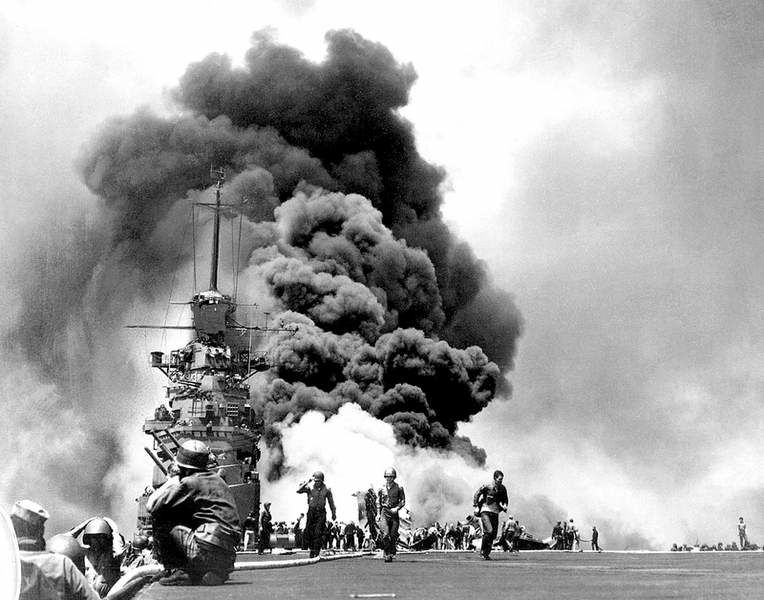Joseph Carmichael Jr., hero of USS Bunker Hill
Published 5:00 am Sunday, October 2, 2011

- Smoke billows from the aircraft carrier Bunker Hill after an attack on May 11, 1945. Lt. Cmdr. Joseph Carmichael Jr., who received the Navy Cross for acting to save the Bunker Hill after two kamikaze strikes, died Sept. 26. He was 96.
It was midmorning on May 11, 1945, near the Japanese island of Kyushu when the USS Bunker Hill, an aircraft carrier with dozens of planes and vast stores of fuel and ammunition on its flight deck, was struck by two kamikaze planes in suicide attacks within minutes of each other.
Lt. Cmdr. Joseph Carmichael Jr., the Bunker Hill’s chief engineer, had just finished his shift and was in his office doing paperwork. “He could definitely have stayed there and never been criticized,” said Maxwell Taylor Kennedy, the author of “Danger’s Hour: The Story of the USS Bunker Hill and the Kamikaze Pilot Who Crippled Her.” The book recounts what could have been a far more calamitous day but for the bravery of Carmichael and his engineering crew.
“Instead,” Kennedy said in an interview Wednesday, “he ran down through five decks, passing sailors who were evacuating, and made it to the engine compartment about 25 feet below sea level. This was in a ship that he knew was burning above him and could sink at any moment.”
Carmichael, who would receive the Navy Cross for “extraordinary heroism” in keeping the Bunker Hill afloat that day, but who would never forget the loss of many men under his direct command, died Monday in Manhattan after a long illness, said his wife, Jeanne. He was 96.
His actions, and those of his men, are credited with helping to save not just the ship but nearly 2,800 crew members as well.
The first kamikaze aircraft dropped a bomb through the flight deck and into the hangar below, then crashed into the deck, raking through most of the planes on board and setting them ablaze. The second slammed into the control tower and pierced the deck, where its bombs exploded. Flames and towering plumes of toxic smoke enveloped the carrier’s upper decks.
Deep below, in the engine and boiler rooms, Carmichael and his 500 or so men kept the engines running, controlling dials in the smoke-filled dark, enabling the Bunker Hill to sail out of the range of further attacks. They kept fans blowing so that air reached oxygen-starved men below decks, and ran pumps that brought in seawater to fight the fires. They remained at their posts for nearly 20 hours.
At one point, wrote Kennedy, a son of Robert F. Kennedy, Carmichael defused panic on board when “he opened the public address system and announced: ‘This is the chief engineer speaking. The ship is not sinking. It is not in any danger of sinking. And it will not sink. So put your minds at rest on that.’
“Many sailors,” Kennedy added, “point to the time they heard those words as the defining moment in the struggle to save the Bunker Hill.”
But smoke kept pouring into the engine and boiler rooms, and 125 men in the engineering crew died. In all, 393 of the Bunker Hill’s sailors perished, and the next day 352 were buried at sea. Though badly damaged, the carrier returned under its own power to Pearl Harbor.
“By his professional skill, courage and devotion to duty,” Carmichael’s Navy Cross citation says, he “upheld the highest traditions of the United States Naval Service.”
Joseph Rix Carmichael Jr. was born on June 13, 1915, in Eureka, Utah, the eldest of five children of Joseph and Mary Silver Carmichael. His father was a gold miner. At the University of Washington, from which he graduated in 1939 with a degree in forestry, he joined the Navy Reserve Officers Training Corps. A year later, he was called to active duty, and in 1943 he was assigned to the Bunker Hill.
After the war, Carmichael bought a logging company in British Columbia. When it failed, he and his first wife, Sylvia, who died in 1986, moved to New York, where he became a real estate developer and, later, a banking executive.






